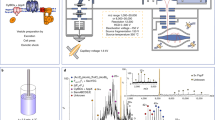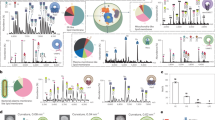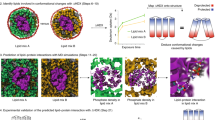Abstract
With the recent success in determining membrane protein structures, further detailed understanding of the identity and function of the bound lipidome is essential. Using an approach that combines high-energy native mass spectrometry (HE-nMS) and solution-phase lipid profiling, this protocol can be used to determine the identity of the endogenous lipids that directly interact with a protein. Furthermore, this method can identify systems in which such lipid binding has a major role in regulating the oligomeric assembly of membrane proteins. The protocol begins with recording of the native mass spectrum of the protein of interest, under successive delipidation conditions, to determine whether delipidation leads to disruption of the oligomeric state. Subsequently, we propose using a bipronged strategy: first, an HE-nMS platform is used that allows dissociation of the detergent micelle at the front end of the instrument. This allows for isolation of the protein–lipid complex at the quadrupole and successive fragmentation at the collision cell, which leads to identification of the bound lipid masses. Next, simultaneous coupling of this with in-solution LC-MS/MS-based identification of extracted lipids reveals the complete identity of the interacting lipidome that copurifies with the proteins. Assimilation of the results of these two sets of experiments divulges the complete identity of the set of lipids that directly interact with the membrane protein of interest, and can further delineate its role in maintaining the oligomeric state of the protein. The entire procedure takes 2 d to complete.
This is a preview of subscription content, access via your institution
Access options
Access Nature and 54 other Nature Portfolio journals
Get Nature+, our best-value online-access subscription
$29.99 / 30 days
cancel any time
Subscribe to this journal
Receive 12 print issues and online access
$259.00 per year
only $21.58 per issue
Buy this article
- Purchase on Springer Link
- Instant access to full article PDF
Prices may be subject to local taxes which are calculated during checkout







Similar content being viewed by others
Accession codes
References
Konijnenberg, A. et al. Global structural changes of an ion channel during its gating are followed by ion mobility mass spectrometry. Proc. Natl. Acad. Sci. USA 111, 17170–17175 (2014).
Schiffrin, B. et al. Skp is a multivalent chaperone of outer-membrane proteins. Nat. Commun. 23, 786–793 (2016).
Harvey, S.R., Liu, Y., Liu, W., Wysocki, V.H. & Laganowsky, A. Surface induced dissociation as a tool to study membrane protein complexes. Chem. Commun. 53, 3106–3109 (2017).
Zhang, H. et al. Native mass spectrometry characterizes the photosynthetic reaction center complex from the purple bacterium Rhodobacter sphaeroides. J. Am. Soc. Mass Spectrom. 28, 87–95 (2017).
Iadanza, M.G. et al. Lateral opening in the intact beta-barrel assembly machinery captured by cryo-EM. Nat. Commun. 7, 12865 (2016).
Landreh, M., Marklund, E.G., Uzdavinys, P. & Degiacomi, M.T. Integrating mass spectrometry with MD simulations reveals the role of lipids in Na+/H+ antiporters. Nat. Commun. 8, 13993 (2017).
Gupta, K. et al. The role of interfacial lipids in stabilizing membrane protein oligomers. Nature 541, 421–424 (2017).
Hedger, G. & Sansom, M.S. Lipid interaction sites on channels, transporters and receptors: recent insights from molecular dynamics simulations. Biochim. Biophys. Acta 1858, 2390–2400 (2016).
Landreh, M., Marty, M.T., Gault, J. & Robinson, C.V. A sliding selectivity scale for lipid binding to membrane proteins. Curr. Opin. Struct. Biol. 39, 54–60 (2016).
Norimatsu, Y., Hasegawa, K., Shimizu, N. & Toyoshima, C. Protein-phospholipid interplay revealed with crystals of a calcium pump. Nature 545, 193–198 (2017).
Le Roy, A. et al. AUC and small-angle scattering for membrane proteins. Methods Enzymol 562, 257–286 (2015).
Maekawa, S., Kobayashi, Y., Morita, M. & Suzaki, T. Tight binding of NAP-22 with acidic membrane lipids. Neurosci. Lett. 600, 244–248 (2015).
Deme, J.C. et al. Purification and interaction analyses of two human lysosomal vitamin B12 transporters: LMBD1 and ABCD4. Mol. Membr. Biol. 31, 250–261 (2014).
Zhou, M. et al. Mass spectrometry of intact V-type ATPases reveals bound lipids and the effects of nucleotide binding. Science 334, 380–385 (2011).
Bechara, C. et al. A subset of annular lipids is linked to the flippase activity of an ABC transporter. Nat. Chem. 7, 255–262 (2015).
Gault, J. et al. High-resolution mass spectrometry of small molecules bound to membrane proteins. Nat. Methods 13, 333–336 (2016).
Marcoux, J. et al. Mass spectrometry reveals synergistic effects of nucleotides, lipids, and drugs binding to a multidrug resistance efflux pump. Proc. Natl. Acad. Sci. USA 110, 9704–9709 (2013).
Liko, I. et al. Dimer interface of bovine cytochrome c oxidase is influenced by local posttranslational modifications and lipid binding. Proc. Natl. Acad. Sci. USA 113, 8230–8235 (2016).
Mehmood, S. et al. Mass spectrometry captures off-target drug binding and provides mechanistic insights into the human metalloprotease ZMPSTE24. Nat. Chem. 8, 1152–1158 (2016).
Laganowsky, A., Reading, E., Hopper, J.T. & Robinson, C.V. Mass spectrometry of intact membrane protein complexes. Nat. Protoc. 8, 639–651 (2013).
Sun, J., Kitova, E.N., Sun, N. & Klassen, J.S. Method for identifying nonspecific protein-protein interactions in nanoelectrospray ionization mass spectrometry. Anal. Chem. 79, 8301–8311 (2007).
Ilgu, H. et al. Variation of the detergent-binding capacity and phospholipid content of membrane proteins when purified in different detergents. Biophys. J. 106, 1660–1670 (2014).
Sun, J., Kitova, E.N. & Klassen, J.S. Method for stabilizing protein-ligand complexes in nanoelectrospray ionization mass spectrometry. Anal. Chem. 79, 416–425 (2007).
Campuzano, I.D. et al. Native MS analysis of bacteriorhodopsin and an empty nanodisc by orthogonal acceleration time-of-flight, orbitrap and ion cyclotron resonance. Anal. Chem. 88, 12427–12436 (2016).
Barrera, N.P., Di Bartolo, N., Booth, P.J. & Robinson, C.V. Micelles protect membrane complexes from solution to vacuum. Science 321, 243–246 (2008).
Liko, I., Hopper, J.T., Allison, T.M., Benesch, J.L. & Robinson, C.V. Negative ions enhance survival of membrane protein complexes. J. Am. Soc. Mass Spectrom. 27, 1099–1104 (2016).
Hernandez, H. & Robinson, C.V. Determining the stoichiometry and interactions of macromolecular assemblies from mass spectrometry. Nat. Protoc. 2, 715–726 (2007).
Bird, S.S., Marur, V.R., Sniatynski, M.J., Greenberg, H.K. & Kristal, B.S. Lipidomics profiling by high-resolution LC-MS and high-energy collisional dissociation fragmentation: focus on characterization of mitochondrial cardiolipins and monolysocardiolipins. Anal. Chem. 83, 940–949 (2011).
Allison, T.M. et al. Quantifying the stabilizing effects of protein-ligand interactions in the gas phase. Nat. Commun. 6, 8551 (2015).
Mehmood, S. et al. Charge reduction stabilizes intact membrane protein complexes for mass spectrometry. J. Am. Chem. Soc. 136, 17010–17012 (2014).
Tsugawa, H. et al. MS-DIAL: data-independent MS/MS deconvolution for comprehensive metabolome analysis. Nat. Methods 12, 523–526 (2015).
Acknowledgements
The Robinson group is funded by a Wellcome Trust Investigator Award (104633/Z/14/Z), an ERC Advanced Grant ENABLE (641317) and an MRC program grant (MR/N020413/1). K.G. is a Junior Research Fellow at St Catherine's College, Oxford, and is supported by the Royal Commission for the Exhibition of 1851. J.G. is a Junior Research Fellow of The Queen's College. J. Donlan, Waters Corporation and OMass Technologies are thanked for their support.
Author information
Authors and Affiliations
Contributions
K. Gupta expressed and purified LeuT and SemiSWEET, and performed the high-energy experiments with the help of J.T.S.H. C.B. developed the successive delipidation protocol, and J.L. expressed and purified MsbA and performed the successive delipidation experiment. C.B. and J.G. performed the lipidomics experiments and analyzed the data. D.W. set up the lipidomics platform. I.L. expressed, purified and performed the MS experiments on MATE. J.L.P.B., J.T.S.H. and K. Giles designed the high-energy source. K. Gupta and C.V.R. wrote the manuscript with assistance from J.G. and I.L. and input from all other authors.
Corresponding author
Ethics declarations
Competing interests
The authors declare no competing financial interests.
Rights and permissions
About this article
Cite this article
Gupta, K., Li, J., Liko, I. et al. Identifying key membrane protein lipid interactions using mass spectrometry. Nat Protoc 13, 1106–1120 (2018). https://doi.org/10.1038/nprot.2018.014
Published:
Issue Date:
DOI: https://doi.org/10.1038/nprot.2018.014
This article is cited by
-
Regulation of membrane protein structure and function by their lipid nano-environment
Nature Reviews Molecular Cell Biology (2023)
-
Emergence of mass spectrometry detergents for membrane proteomics
Analytical and Bioanalytical Chemistry (2023)
-
Structural basis for lipid and copper regulation of the ABC transporter MsbA
Nature Communications (2022)
-
Anionic lipids unlock the gates of select ion channels in the pacemaker family
Nature Structural & Molecular Biology (2022)
-
Structural basis of tethered agonism of the adhesion GPCRs ADGRD1 and ADGRF1
Nature (2022)
Comments
By submitting a comment you agree to abide by our Terms and Community Guidelines. If you find something abusive or that does not comply with our terms or guidelines please flag it as inappropriate.



